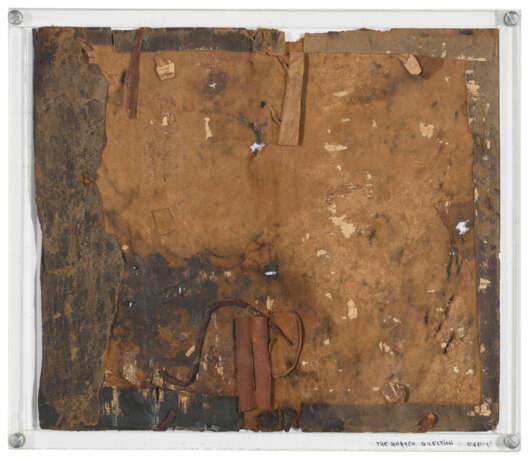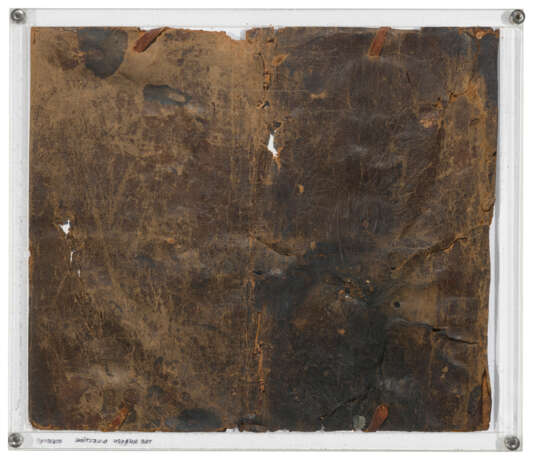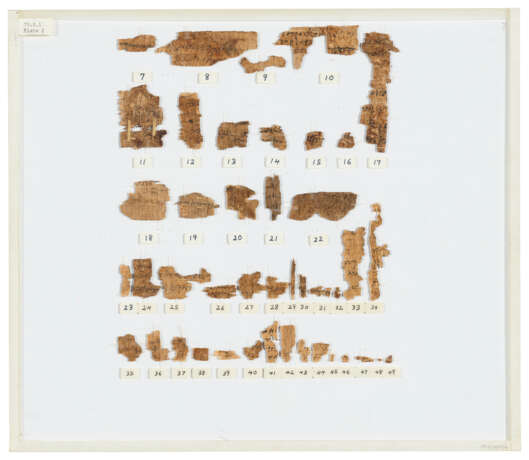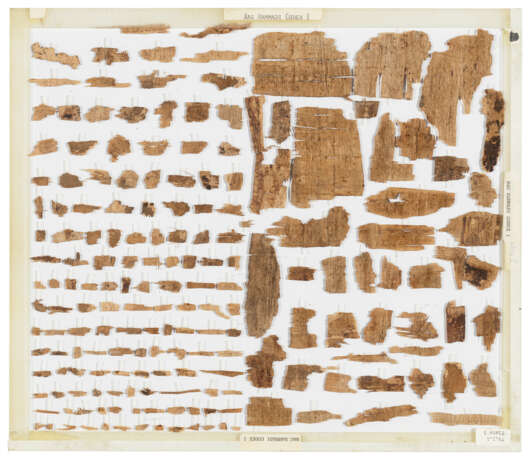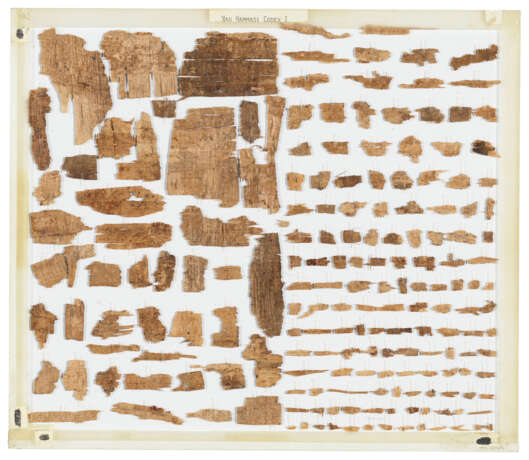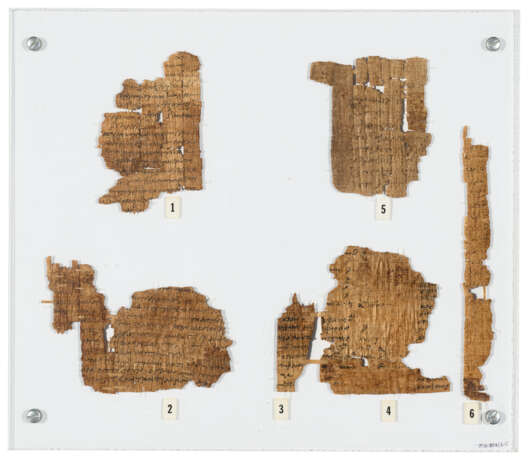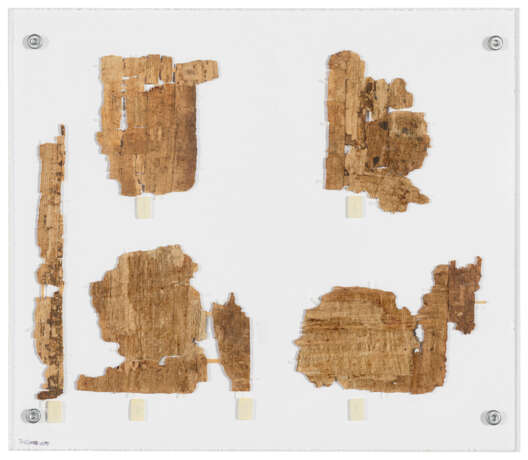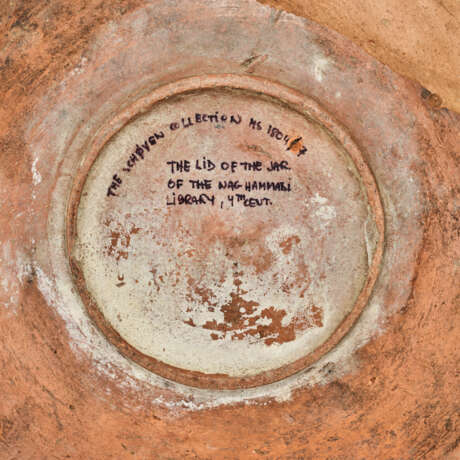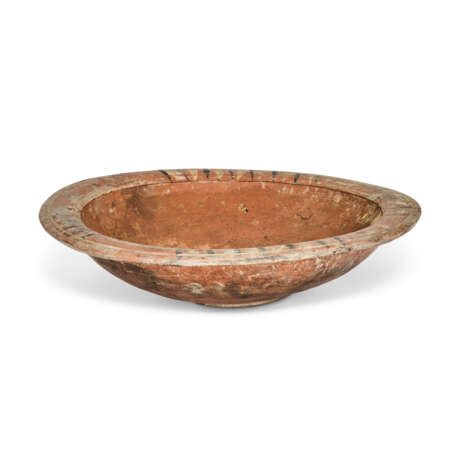ID 1214879
Lot 2 | The Nag Hammadi Binding
Valeur estimée
£ 100 000 – 150 000
The Nag Hammadi Codex I Binding, sheep leather book binding with papyrus cartonnage [Egypt, 4th century]
The earliest known book binding in private hands and one of the earliest book bindings in existence: the cover of Nag Hammadi Codex I, accompanied by the bowl purported to have been used as the lid covering the jar that contained a library of immeasurable importance to the study of early Christianity and Gnosticism: the Nag Hammadi codices.
300 x 150mm closed, 300 x 334mm fully opened; the leather strips at edges folded in and originally pasted down over the cartonnage (now removed and preserved separately); the flap of the outer edge of the upper cover folded in and when opened would have extended up to 70mm to be folded around the edge of the codex with a strap (now missing); thongs to tie the top and bottom survive (only the bottom thong complete though broken); the inside originally lined with 4-6 layers of papyrus as cartonnage; two leather stays survive. An in-depth description of the cover can be found in The Facsimile edition, 1979, pp.XV-XVII.
[With]:
49 inscribed and 183 uninscribed fragments of papyrus cartonnage placed behind three double-sided archival sheets (see The Cartonnage below).
[And]:
The bowl believed to have been used as a lid covering the jar that was said to have contained the Nag Hammadi codices. The bowl corresponds to the Gempeler T210B type (R.D. Gempeler, Elephantine X. Die Keramik rimischen bisfriihdrabischer Zeit, 1992, figs 10.7-8), and is a local imitation of North-African terra sigillata in Aswan clay, with an orange polished slip and painted decoration on the rim (group O in M. Rodziewicz, Alexandrie I. La céramique romaine tardive d'Alexandrie, 1976). The production of these bowls is datable to between the last quarter of the 4th and the first half of the 6th century. Similar bowls were found in nearby Pachomian monastic complexes. On the outer surface, the bowl features black traces of an organic substance, perhaps resin (described by J.M. Robinson as 'bitumen' and by E. Goehring as 'tar-like' (Goehring, 2006) — see Provenance below).
Provenance:
(1) The discovery of the Nag Hammadi codices has been a topic of heated debate for close to a century. One of four outstanding finds of buried papyri and parchments which transformed study of the Bible and early Christianity (the others being the Dead Sea Scrolls, which were recovered from 1947 in a series of discoveries in the Judaean Desert, chiefly in Hebrew with some Greek and Aramaic material, and dating from the 2nd century BC to the 1st century AD; the 'Chester Beatty Biblical Papyri', a group of 11 papyrus codices of Greek biblical texts dating from the 2nd to 5th centuries, found in 1930; and the Bodmer Papyri found in the early 1950s), they comprised twelve single-quire codices (I-XII) of papyrus, tacketed into leather covers; and an unbound tractate (Codex XIII), placed inside the cover of Codex VI. The texts were all written in Coptic, the most important of which is considered to be the Gospel of Thomas in Codex II, the only known complete copy of that Gospel. Also known as the Chenoboskion Manuscripts, they comprise mostly Gnostic treatises and are of immeasurable importance to the study of early Christianity and Gnosticism. The stories attached to their discovery in 1945 have undoubtedly been romanticised over the years, and have led some modern academics to accuse earlier scholars of Orientalism.
The most recent analysis of the Nag Hammadi 'find story' is by Paul Linjamaa (The Nag Hammadi Codices and their Ancient Readers: Exploring Textual Materiality and Reading Practice, 2024, esp. pp.49-67). He summarises the earliest accounts by scholars on the scene; the first of whom was Jean Doresse, who travelled to Egypt at the end of the 1940s and was told by his local guide that the texts were found in a large earthenware jar by peasants digging for fertiliser (J. Doresse, ‘Sur les traces des papyrus gnostiques: Recherches à Chenoboskion’, Bulletin de l’Académie royale de Belgique, Classe des Lettres 36:5 (1950), pp.432-439). This provided the basis for the story that has gained the most traction over the years: James Robinson's detailed, colourful and engaging account, full of superstition, jinn, murder, and rival clans, with the figure of the camel-driver Muhammad Ali al-Samman and his mother at the centre of it. This story has, in recent times, been vigorously challenged as being full of Western prejudice and steeped in Orientalist attitudes (namely by M. Goodacre, ‘How Reliable Is the Story of the Nag Hammadi Discovery?’, Journal for the Study of the New Testament 35:4 (2013), pp.303-322; and N. D. Lewis and J. A. Blount, ‘Rethinking the Origins of the Nag Hammadi Codices’, Journal of Biblical Literature 133:2 (2014), pp.399–419). Lewis and Blount further maintain that the texts were not found near the slopes of Hamra Dun, outside the modern city of Nag Hammadi, and were not the buried libraries of Pachomian monks, but rather 'books of the dead' found at a burial ground, intended to guide souls to heaven. Other scholars, on the other hand, have corroborated elements of Robinson's story, and indeed Muhammad Ali al-Samman himself recounted his version of events in his own words in a 1987 Channel 4 documentary for UK television. Initial accounts of the find included reports of a bowl used to seal the jar in which the texts were discovered (that earthenware bowl is offered with the present lot): this was in fact one way in which earthenware jars were sealed, and bowls such as the one offered with the present lot have been found in Pachomian monasteries (see Goehring, 2006). Linjamaa believes that Goodacre, Lewis and Blount go too far in their criticism of the 'find story', that Robinson was in fact very meticulous (in this he follows B. Nongbri, ‘Finding Early Christian Books at Nag Hammadi and Beyond’, Bulletin for the Study of Religion 45 (2016), p.13, and D. Burns, ‘Telling Nag Hammadi’s Egyptian Stories’, Bulletin for the Study of Religion 45 (2016), pp.5-11), and that the nature of the Nag Hammadi texts themselves needs to be recontextualised.
(2) Joseph Albert Eid (1885-1950), antiquities dealer of Cairo and Brussels. The present lot is the binding of Nag Hammadi Codex I (importantly not the contents of the binding, otherwise known as the Jung Codex, which have particularly complicated and problematic early provenance and ended up travelling from America to Belgium to Switzerland and back to Egypt, where it is now Cairo, Coptic Museum, Inv. 10554, 10589, 10590, 11597, and 11640): it was purchased c.1949 by an anonymous private French collector who has recently been identified (see J.M. Robinson, The Nag Hammadi Story, 2014, pp.383-390), as:
(3) Jean Doresse (1917-2007), of Paris, art historian and Egyptologist, who published the binding in 1961 (see Literature).
(4) Institute for Antiquity and Christianity at Claremont College, California. The binding was brought to Claremont by Doresse on 29 August 1972. On 18 September 1972 the Technical Sub-Committee of the International Committee for the Nag Hammadi Codices met in Cairo, together with Gamal Mokhtar, President of the Egyptian Antiquities Organization, Pahor Labib, Director Emeritus, and Victor Girgis, then Director of the Coptic Museum, on which occasion the binding was offered to the Egyptian government. The Egyptian government declined, and authorised its purchase by Claremont, who paid the balance to Doresse on 4 January 1973. Acquired in April 1994 from Claremont by:
(5) The Schøyen Collection, MS 1804.
Dating:
The most recent and comprehensive analysis of the dating of the Nag Hammadi codices and their bindings has been carried out by Hugo Lundaug (Lundaug, 2021). With the exception of the very earliest publications on the find, which suggested a 3rd-century dating (in 1949 Doresse proclaimed them the earliest extant covers), a 4th-century date has generally been accepted by the academic community. To the established and rich scholarship on the dating of the codices, which is based on archaeological context (including the associated bowl and similar earthenware survivals in the Pachomian monastery at Pbow); colophons within the texts themselves; the contents of the cartonnage present in the manuscripts, which included documents, monastic letters and dated fragments (one of which provides a terminus post quem of 348 for Codex VII); and palaeography, with the same scribes working across several of the codices and therefore situating them within a necessarily restricted timeframe (the scribe of Codex I also worked on Codex XI, while a scribe who worked on Codex XII also worked on Codex VII, for example); Lundaug adds radiocarbon dating, specifically of a fragment of the present binding and some of its uninscribed cartonnage. His conclusions lead to a dating of c.308-387, which when taken in conjunction with the fact that Codex I shared a scribe with Codex XI, and Codex XI shared a scribe with a manuscript with a terminus post quem date of 348 (Codex VII), the most likely date for our binding is the middle of the 4th century.
Even then, the Nag Hammadi bindings are without doubt among the oldest extant book covers, and the present binding is the only one not in a institutional collection. In The Facsimile Edition, 1984, pp.74-75, a small handful of other manuscripts with comparably early bindings are listed, primarily from those among the Bodmer Papyri. To these can also be added the Codex Glazier, Morgan Library and Museum MS G.67, whose binding is datable to the 5th century.
Codex I, now at the Coptic Museum in Cairo, contains a series of Gnostic texts: the Prayer of the Apostle Paul; the Apocryphon of James; the Gospel of Truth; a treatise on the Resurrection; and the Tripartite Tractate discussing Valentinian views on creation and cosmology.
The Cartonnage:
The 49 inscribed fragments of cartonnage are, with the exception of one tiny fragment in Coptic, all in Greek and all apparently secular in nature. They are fully published in the Facsimile edition. When the cover of Codex I was brought to Claremont by Doresse in 1972, cartonnage was still in place toward the bottom of the front cover, though some had been put in an envelope. On 28-31 October 1973 and 28 March 1975 the cartonnage was removed from the cover of Codex I by Anton Fackelman (Barns, 1981, p.ix). It is now divided between three double-sided archival sheets.
The first sheet contains 6 inscribed fragments of papyrus cartonnage, individually numbered (for a full analysis of these, see Barns, 1981, pp.15-23, a summary of which is provided below):
1. An undertaking by oil-workers in a village in the Little Diopolite nome to continue and expand their responsibility in this enterprise. 75 x 115mm.
2. A fragment of a sale or a legal settlement. 140 x 100mm.
3 and 4. Two non contiguous fragments of a private account 'to some degree concerned with weaving and weavers'. 25 x 68mm and 88 x 100mm.
5 and 6. Two non-contiguous fragments of a private letter, with faint traces of the address on the reverse. 75 x 90mm and 20 x 185mm.
The second sheet contains 43 inscribed fragments of papyrus cartonnage, individually numbered. These are miscellaneous documentary fragments, largely unidentifiable.
The third sheet contains 183 uninscribed fragments of papyrus cartonnage.
Literature
Barns, J.W.B., et al., eds., Nag Hammadi Codices, 1981.
Doresse, J., L’Evangile de Thomas, 1959, illustrating the front cover.
Doresse, J., ‘Les Reliures des Manuscrits Gnostiques Coptes découverts a Khenoboskion’, Revue d’Egyptologie, 13 (1961), pp.27-50, esp. pp.47-48, ill. pl.6.
Goehring, J.E., ‘An Early Roman Bowl from the Monastery of Pachomius at Pbow and the Milieu of the Nag Hammadi Codices’, Coptica – Gnostica – Manichaica: Mélanges offerts à Wolf-Peter Funk, 2006, pp.357-371, esp. pp.361-363.
Lundhaug, H., 'Dating and Contextualising the Nag Hammadi Codices and their Texts: A Multi-methodological Approach Including New Radiocarbon Evidence,' Texts in Context, 2021, pp.117-142.
The Facsimile Edition of the Nag Hammadi Codices: Cartonnage, published under the auspices of the Department of Antiquities of the Arab Republic of Egypt, Leiden, 1979 and re-issued 1984.
Exhibited
Conference of European National Librarians, Oslo, September 1994.
'Preservation for access: Originals and copies.' On the occasion of the 1st International Memory of the World Conference, organized by the Norwegian Commission for UNESCO and the National Library of Norway, at the Astrup Fearnley Museum of Modern Art, Oslo, 3 June - 14 July 1996.
| Lieu d'origine: | Egypte, Afrique |
|---|---|
| Catégorie maison de vente aux enchères: | Manuscrits médiévaux et de la Renaissance, Livres et manuscrits |
| Lieu d'origine: | Egypte, Afrique |
|---|---|
| Catégorie maison de vente aux enchères: | Manuscrits médiévaux et de la Renaissance, Livres et manuscrits |
| Adresse de l'enchère |
CHRISTIE'S 8 King Street, St. James's SW1Y 6QT London Royaume-Uni | |
|---|---|---|
| Aperçu |
| |
| Téléphone | +44 (0)20 7839 9060 | |
| Commission | see on Website | |
| Conditions d'utilisation | Conditions d'utilisation |
